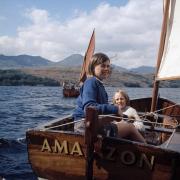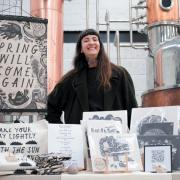A bust of Hampshire amateur diver Alexander McKee, the man who rediscovered the sunken Tudor warship Mary Rose under the Solent silt, has been unveiled by his widow 22 years after his death.
It brought gasps and cheers from guests at the Mary Rose Museum in Portsmouth’s historic dockyard as his 93 year old widow Ilse slipped away the cloth to reveal the bronze.
One of “Macs” volunteer divers, retired shipwright Morrie Young said “Wow. Brilliant. A perfect likeness. I thought it was going to talk to me.”
The ceremony was watched by more than a hundred of Mac’s supporters, some of them his old divers from Southsea and Southampton British Sub Aqua Club, who later formed the BSAC Mary Rose Special Branch.
“Mac”, a military historian and author from Hayling Island, defied doubters and rediscovered “McKee’s Ghost Ship” under the silt of the Solent seabed in the mid-1960s.
The first breakthrough came when Mac and fellow Southsea diver John Towse found the approximate position of the Mary Rose on a chart. It had been marked by the Deane Brothers when they carried out some salvage work on her in the 1840’s. Later a primitive sub seabed sonar trace brought them closer.
That was when the hard work started. Using steel reinforcing rods borrowed from a local builder Mac and his team probed the soft seabed 15 metres underwater. Eventually Don Bullivant, one of “Mad Mac’s Marauders”, struck timber two metres below the silt.
It meant that Mary Rose, which sank in 1545 on her way to fight the French fleet, had be found.
“That was a thrilling moment” said Don who was among the guests at the unveiling.
In 1970 they proved the wreck was the Mary Rose when they brought up a Tudor cannon
Most agree that without Mac’s stubborn determination the Mary Rose would still be lost to the sea.
He was later awarded the OBE and died in 1992 aged 73.
Henry Yelf who was secretary of the Southsea BSAC in the 1960’s and spearheaded the fundraising campaign said “Mac is mentioned a number of times in the museum but if you ask local people who found the Mary Rose often another name crops up. Many of his supporters feel he deserves much greater recognition and that is why we were able to raise £6,500 so quickly.”
The bust was created by Devon sculptor Luke Shepherd working from film and photograph and regularly taking the advice of the family.
Unveiling the bust Mrs McKee said “If Alexander were here he would have a big grin on his face and would say ‘I have made it..I always wanted to make my mark in life”.’
The CEO of The Mary Rose Trust, Rear Admiral John Lippiett raised a toast to Mac and said “We are delighted that Alex’s fundamental and vital role in locating and identifying the Mary Rose has been recognised in this way.”
His schoolteacher daughter Cornelia, also of Hayling Island, who spent much of her youth bobbing up and down on the dive boat keeping the log “Dad would be so proud to see this wonderful museum with the Mary Rose displayed exactly as she envisaged it and this bust is the icing on the cake. Well done dad!”
British Sub Aqua Club Vice President Tony Marshall told guests that he compared Alexander McKee to Alexander the Great as one of history’s most successful commanders “just like McKee with his army of divers who gave so much to this venture.”
Henry Yelf added “Of course the skills of well over a thousand people were vital to bring this fantastic museum into being. It is attracting hoards of visitors from all over the World. Perhaps Portsmouth Council should recognise Macs huge contribution to local coffers and name a street or a building after him.



























